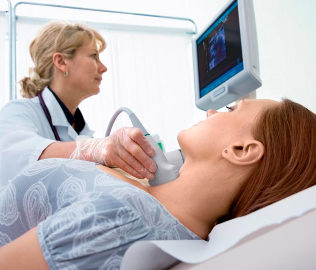
The main function of the lymphatic system of the human body protection against toxins, pathogenic microorganisms and viruses. The most significant elements of this system are the lymph nodes, the size of which normally do not exceed a pea.The lymph nodes contain white blood cells and yellow fluid (lymph).The latter bathes the cells of all organs, localizing the pathogen has changed and the cancer cells in the lymph nodes. This mechanism allows you to delay the spread of infection throughout the body and growth of malignant tumors.
Directly next to the lymph nodes occurs the destruction of cancer cells, viruses, and germs lymphocytes, which began to share. A slight increase in the lymph node may mean that he began to work more actively in connection with the beginning of the disease. If sore lymph node on the neck, it indicates the development of inflammation in its immediate vicinity.
The disease agent is able to penetrate to the lymph nodes in the following ways:
- Called hematogenous way.
- With the help of lymph.
- The contact path.
This reaction has been called lymphadenitis. Pathology of the lymphatic system require a special attention of the doctor because always is the companion of a serious disease. It is therefore necessary to promptly seek qualified medical help.
Causes cervical lymphadenitis's
Swollen lymph nodes in the neck is often one-sided. This defeat mainly to the fact education, which is located near the source of inflammation or infectious lesion. If enlarged lymph nodes encourage the growth of the tonsils, salivary glands, near the ears, lacrimal glands, then you should immediately consult a doctor.

If lymph nodes in the neck enlarged for several months, the doctor may suspect the presence of malignancy. In such cases, there is a sharp decline in the elasticity of the lymphatic vessels, their increasing involvement in the pathological process located near the lymph nodes. He lymph node is firm to the touch, is painful.
Therefore, to increase the lymph node following reasons:
- Bacterial, fungal and viral infections (ARVI, acute tonsillitis, tuberculosis, chickenpox, influenza, toxoplasmosis, rubella, herpes, otitis media, caries, periodontitis).
- Parasites.
- Mechanical injury.
- The human immunodeficiency virus.
- Decrease in immunity. An ongoing illness, stress, hypothermia, lack of vitamins can cause lymphadenitis. Frequent infections can lead to chronic lymphadenitis.
- Autoimmune diseases.
- Toxins in the blood.
- Oncology. Development lymphadenitis's can be the consequence of occurrence of tumours of lymphatic tissue.
- Rarely lymphadenitis cause: alcoholism, disorders in the thyroid or metabolism.
Separately allocate such reasons lymphadenitis's:
- Allergic to drugs.
- Allergic to insect toxins.
- Immune response for the vaccine.
In such cases, there is enlargement of lymph nodes, pronounced tenderness, perhaps swelling of the face, fever, chills.
Classification of the disease
There are several stages lymphadenitis's depending on the symptoms:
- Sore lymph nodes in neck slightly, determined by palpation a small increase. The patient may note weakness, headache and elevated body temperature for a long time.
- The lymph node is greatly enlarged, is determined visually (the size can vary from pea to egg), pain on palpation during the act of swallowing. The patient complains of weakness, increased body temperature, discomfort during head rotation, decreased appetite, headaches.
- Severe pain and redness in the area of the lymph node indicate the development of purulent inflammation. Patient has high fever (up to 40), fever, chills, bad mood, apathy, nausea and vomiting. Constant headaches, dizziness can indicate a serious intoxication.
In chronic lymphadenitis the symptoms listed above can be absent. To diagnose the pathology is very problematic, because the lymph nodes can almost not noticeable to the touch. In such cases, the absence of treatment will lead to a gradual and irreversible degeneration of the cervical lymph nodes.
Cervical lymphadenitis in children
Swollen lymph nodes are common in children who often suffer from colds. The inflammatory process can occur even in childhood, however, in such cases the diagnosis of node is difficult. Children often swollen lymph nodes during a cold and will go away themselves after recovery. Also, be aware that some of the lymph nodes because of its special location (the individual characteristics of the child) can only seem enlarged and do not require treatment.
The reasons for the development lymphadenitis's children are many, the most common:
- Bacterial and viral infection (sore throat, influenza, toxoplasmosis, mononucleosis).
- The reaction for the vaccination.
- Damage to the skin (scratches, cats, rodents).
Remember!
If the lymph node is bothering the child for a long time for no apparent reason, in the body is inflammation. A final diagnosis and to appoint effective treatment can only be a doctor after conducting proper diagnosis.
Lymphadenitis pregnant women
A special danger lies in the inflammation of the lymph nodes during pregnancy because this disease can leave negative consequences for both the mother and the fetus. The disease occurs due to the reduction of immunity of women during pregnancy, it may trigger the same factors. In such cases, difficulties may arise when choosing drugs.
During pregnancy is strictly forbidden to treat lymphadenitis alone. You must contact the doctor who will be able to find out the cause of the inflammation, to prescribe effective and safe medications. Treat your health carefully and at the first symptoms it is better to consult a specialist.

The main methods of diagnosis of pathology
There are over a hundred different diseases that can cause a reaction of the lymphatic system. It is therefore necessary to perform differential diagnostics of disease, paying attention to even the minor symptoms.
Today, the most accessible and informative method of diagnosis is ultrasonography (us). It allows you to determine the size and shape of the lymph nodes, evaluate their structure, in some cases, the nature of the lesion formations. For example, herpetic infection leads to an increase in multiple lymph nodes simultaneously.
It is important to understand that the possibilities of ultrasound is limited, so to confirm the diagnosis may need to conduct additional clinical and laboratory research:- Clinical analysis of blood.
- MRI.
- CT.
- The x-rays.
- Lymph node biopsy followed by a histological study of tissues.
Important!
X-ray method will be effective only if calcification lymph node, that is, the deposition in lymphoid formations of calcium salts. For such changes will take several years or severe metabolic disorders.
Treatment
If sore lymph nodes in the neck, the therapy should include treatment that will effectively eliminate the inflammation and all signs of disease. Treatment should be chosen strictly individually depending on the causes of the disease and its stage. It is important to remember that the lymphatic system is a physiological shield for the body with the ability to produce lymphocytes, which are able to deal with pathogens of different nature (viruses, bacteria, parasites). Therefore, with a simple inflammation of the body is able to cope on their own.
 If the lymph node is sore for a long time on the background of General intoxication, the widely used following treatment regimen:
If the lymph node is sore for a long time on the background of General intoxication, the widely used following treatment regimen:
- Reduced physical activity, bed rest, drinking plenty of fluids.
- The use of anti-inflammatory drugs, which have a mild antibacterial effect. The ineffectiveness perhaps the use of steroid drugs.
- The additional use of painkillers and antibiotics of wide spectrum of action on the background of tonics, vitamin preparations will speed up the recovery.
- It is possible to use traditional methods as an additional treatment: gargle with a decoction of herbs (chamomile, calendula), which will locally affect the area of inflammation. It is important to remember that traditional medicine can act only as auxiliary treatment.
- Power correction. It is necessary to increase the consumption of vitamins of vegetables and fruits (onions, citrus) that will help in the fight against infection, add dairy products.
- Appointment UHF-therapy will reduce the recovery time. This therapeutic technique is based on the electromagnetic field of ultrahigh frequencies on the inflamed area.
- In the absence of timely medical help in severe clinical cases, resort to surgical therapy (conducted by a puncture or total excision of a lymph node).
When lymphadenitis the lymph node may not be heated, grind and apply on the affected area with iodine. These measures can provoke the spread of infection, increasing the risk of brain damage.
Basic preventive measures
Specific prevention lymphadenitis's does not exist, because this disease is polyetiological disease (pathology develops for many reasons).
 However, to prevent the inflammation of the lymph nodes will allow the following activities:
However, to prevent the inflammation of the lymph nodes will allow the following activities:
- Regular hardening.
- The maintenance of a healthy immune system.
- Timely treatment of acute infectious diseases that will not allow them to become chronic.
- Minimize hypothermia and stay in the cold air.
- To reduce the risk of injury, and wound infections.
It is important to remember that any discomfort in the neck, head and under the jaw, in most cases, are anxiety symptoms. Lymph nodes in the neck increase in size and hurt only in the presence of serious inflammatory process. To avoid radical surgical intervention is necessary when you experience pain, immediately consult a specialist and comply with all requirements.

























